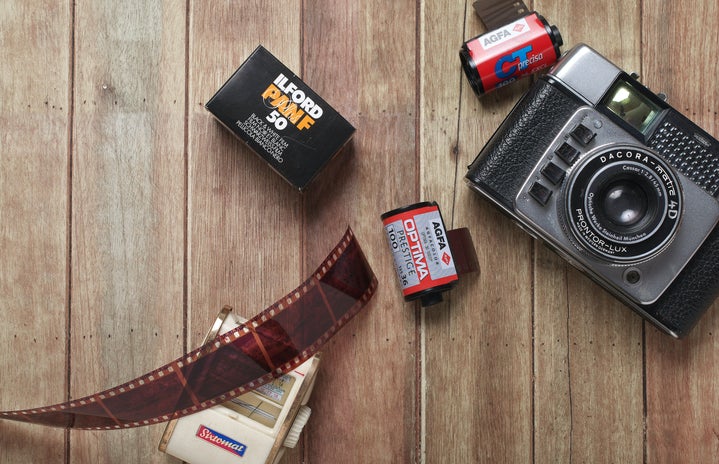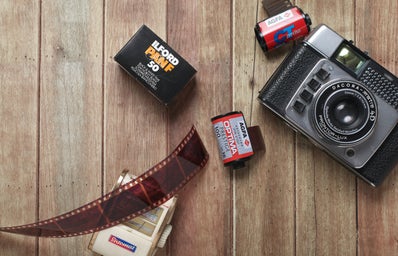There was a general belief that film photography would be obsolete due to the rise of digital photography and the constant improvement of mobile phone cameras. However, that has not been the case.
There is a movement towards the return to film photography, mainly in digital communities, under the hashtag #filmisnotdead. Not only that, outside the web, there’s a trend of people using instant cameras to take their pictures. For example, lots of people are using a model of instant camera called Instax to capture special moments. And proof of that is in the numbers: Fujifilm (a company that produces photographic film and the trendy Instax), has sold 500.000 Instamax cameras in 2010 and 10 million in 2020.
What is film photography, and why is it different from digital photography?
The main difference is in the way the image is captured. While digital photography uses a sensor to generate the photo and store it in a memory card, analog photography puts the picture on film using light and keeps it in the form of a negative.
Another difference is how each result is obtained. Digital photography shows the picture that was taken on a screen and in mere seconds. Film photography, on the other hand, needs to be developed and printed before the person sees it.
An exception to that would be the instant cameras, like Polaroid and Instax. These models, like film photography, don’t store the pictures and need to be filled with film to work. But they also expose and print the photos on paper right after they are taken, something that resembles the instantaneous aspect of digital photography.
Why is film photography making a comeback?
There’s an infinite number of reasons that would lead someone to choose analog over digital, and they depend on the person’s relationship with photography. But here are a few of them.
The desire to have something tangible in hand could capture the attention of many and direct them towards the analog. In a world where things are being transported more and more to digital files, having a physical object, like a film roll or a Polaroid picture, can attract many photographers.
Another reason could be the aesthetics of film technology. The vintage look, with colors that cannot be replicated with the digital format, and the unique aspect of each photo contrast with the images that can be mass-produced with mobile phones and digital cameras. The distinct appearance of a film picture catches the eye and creates a yarn to photograph like that.
A third motivation might be the challenge that is to practice analog photography. The technology used in this format doesn’t rely so heavily on software that controls things such as light exposure and color correction, which makes taking a good photo with film that big of technical prowess. And that could attract someone who is looking to deepen their photographic abilities.
All that, in a period when anyone can simply take a picture with their phone, makes film photos gain the spotlight.
What you need to know before you start to practice film photography:
A big matter of film photography is the cost of it all. Before anything else, their prices have been on the rise due to the increasing interest in the format, and the same can be applied to the film rolls.
Still, on the topic of the film, it’s important to take into account that their prices vary according to the number and type of photos they support: films that are colored and can take more pictures in a single roll are usually more expensive. Also, the costs of the film purchase and development are constant.
On this development point, a solution could be to build your own lab at home, but that also demands a certain investment, since you’d have to build a dark room and buy all the chemicals needed to make the whole process. Nevertheless, it’s essential to develop the photos, so you can see them. So, it’s easier to use analog photography in places that have the infrastructure needed to develop and print the pictures.
Another requirement of the format is a bit of a high level of knowledge about the technical side of photography. For example, it’s important to dominate to a certain point the exposure triangle, understand the different types of film, their sensibility to light and how that affects the photo etc. Not only that, but the film also limits the number of pictures you can take, so you ́ll have to plan each photo very carefully.
The cost of the film rolls needs to be added to all of that, which makes every single photo precious. In other words, the emphasis of the photography should be dislocated from the sheer amount of pictures that are taken and placed on their quality instead. Despite all that, it’s important to know that this whole process creates a bigger conscience of what could be a great photo and what would not be so interesting.
However, this shouldn’t discourage anyone who’s thinking about giving their first steps into the world of photography. If your goal is to take pictures with an analog camera one day, then a good path for you could be to start with a digital camera to then make the change to an analog one. This way, it’s easier to learn all the technical principles you’ll need to know to eventually use the film to take your pictures.
——————————————————————————————————————————————–
The article above was edited by Marina Ponchio.
Liked this type of content? Check Her Campus Casper Libero’s home page for more!


